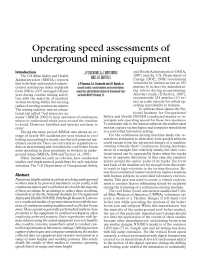Mining Publication: Operating Speed Assessments of Underground Mining Equipment
Original creation date: March 2010
Numerous fatal/nonfatal accidents involving underground workers struck by powered machinery occur yearly, with continuous miners and roof bolters involved in the majority of these accidents. In an attempt to reduce these accidents, researchers at the National Institute for Occupational Safety and Health (NIOSH) Pittsburgh Research Laboratory conducted studies of operator interactions with the motions of continuous mining machines and roof bolter boom arms. These operators generally perform their tasks in close proximity to the equipment in confined workspaces, often employing awkward postures. Since experiments with human subjects using the actual equipment were not feasible due to safety concerns, researchers opted to conduct controlled experiments in laboratory settings. Utilizing motion capture technologies and computer simulations, the studies collected data on equipment and operator movement in a range of seam heights and working postures. This publication details the results of these studies to examine operating speeds based on usage and seam height.
Authors: JP DuCarme, AJ Kwitowski, JR Bartels
See Also
- Independent Contractors
- Injuries, Illnesses, and Hazardous Exposures in the Mining Industry, 1986-1995: A Surveillance Report
- Mining Fact Sheets
- Overall Mining Facts 2008 (HTML)
- Proximity Detection
- Refuge Alternatives in Underground Coal Mines
- Rib Falls: A Major Ground Control Issue
- Roof and Rib Fall Incident Trends: a 10-Year Profile
- Statistics: All Mining
- Underground Coal Mining Disasters and Fatalities: United States, 1900-2006
- Wireless Mesh Mine Communication System
- Content source: National Institute for Occupational Safety and Health, Mining Program


 ShareCompartir
ShareCompartir
